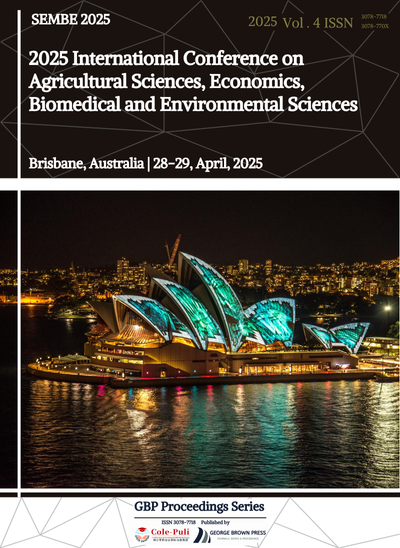Effects of Deficit Mulched Drip Irrigation on Water Productivity of Pepper in a Cold and Arid Environment
DOI:
https://doi.org/10.71222/1mbapg50Keywords:
water deficit, water consumptio, water use efficiency, Jensen modelAbstract
To assess the impact of water deficit (WD) under film-mulched drip irrigation on pepper yield and water use efficiency (WUE), a field experiment was conducted with three levels of WD: mild (65%-75% field capacity, FC), moderate (55%-65% FC), and severe (45%-55% FC). WD treatments were applied during the seedling, flowering and fruiting, full fruiting, and late fruiting stages, with full irrigation (75%-85% FC) throughout the growing season serving as the control (CK). Results showed that WD during the flowering and fruiting stages significantly reduced pepper yield by 11.68%-25.56%, fruit number per plant by 18.18%-45.45%, and single fruit weight by 17.33%-19.94% compared to CK. However, moderate WD at the seedling stage and mild or moderate WD at the later fruiting stage significantly improved WUE by 6.25%-11.61% without significantly reducing fruit yield or harvest index relative to CK. The Jensen-based crop water production function revealed that the flowering and fruiting stages, with a water sensitivity index of 0.517, are critical for pepper's water needs, emphasizing the importance of adequate irrigation during this period for higher yields. Thus, water-saving and efficient pepper production can be achieved through deficit irrigation with under-membrane drip irrigation.
References
1. Y. Cao, W. Zhang, and J. Ren, “Efficiency analysis of the input for water-saving agriculture in China,” Water, vol. 12, no. 1, Art. no. 207, 2020, doi: 10.3390/w12010207.
2. Y. Huang, W. Han, and L. Zhou, “Farmer cognition on water-saving irrigation technology and its influencing factors analysis,” Trans. Chin. Soc. Agric. Eng., vol. 28, no. 18, pp. 113–120, 2012, doi: 10.3969/j.issn.1002-6819.2012.18.017.
3. D. Kou, D. Su, D. Wu, and Y. Li, “Effects of regulated deficit irrigation on water consumption, hay yield and quality of alfalfa under subsurface drip irrigation,” Trans. Chin. Soc. Agric. Eng., no. 2, pp. 116–123, 2014, doi: 10.3969/j.issn.1002-6819.2014.02.015.
4. 999T. Foster and N. Brozović, “Simulating crop-water production functions using crop growth models to support water policy assessments,” Ecol. Econ., vol. 152, pp. 9–21, 2018, doi: 10.1016/j.ecolecon.2018.05.019.
5. Z. Zhengbin, X. Ping, S. Hongbo, L. Mengjun, F. Zhenyan, and C. Liye, “Advances and prospects: Biotechnologically improving crop water use efficiency,” Crit. Rev. Biotechnol., vol. 31, no. 3, pp. 281–293, 2011, doi: 10.3109/07388551.2010.531004.
6. S. Agele, “Global warming and drought, agriculture, water resources, and food security: Impacts and responses from the tropics,” in Handbook of Climate Change Management, W. Leal Filho, J. Luetz, and D. Ayal, Eds. Cham: Springer, 2021. ISBN: 9783030227593.
7. A. Abdelkhalik, B. Pascual, I. Nájera, M. A. Domene, C. Baixauli, and N. Pascual-Seva, “Effects of deficit irrigation on the yield and irrigation water use efficiency of drip-irrigated sweet pepper (Capsicum annuum L.) under Mediterranean conditions,” Irrig. Sci., vol. 38, pp. 89–104, 2020, doi: 10.1007/s00271-019-00655-1.
8. P. Yang, L. Wu, M. Cheng, J. Fan, S. Li, H. Wang, and L. Qian, “Review on drip irrigation: Impact on crop yield, quality, and water productivity in China,” Water, vol. 15, no. 9, Art. no. 1733, 2023, doi: 10.3390/w15091733.
9. A. N. Erickson and A. H. Markhart, “Flower production, fruit set, and physiology of bell pepper during elevated temperature and vapor pressure deficit,” J. Am. Soc. Hortic. Sci., vol. 126, no. 6, pp. 697–702, 2001, doi: 10.21273/JASHS.126.6.697.
10. G.-C. Shao, Z.-Y. Zhang, N. Liu, S.-E. Yu, and W.-G. Xing, “Comparative effects of deficit irrigation (DI) and partial rootzone drying (PRD) on soil water distribution, water use, growth and yield in greenhouse grown hot pepper,” Sci. Hortic., vol. 119, no. 1, pp. 11–16, 2008, doi: 10.1016/j.scienta.2008.07.001.
11. D. Paliwoda and G. Mikiciuk, “Use of rhizosphere microorganisms in plant production–a review study,” J. Ecol. Eng., vol. 21, no. 8, 2020, doi: 10.12911/22998993/126597.











